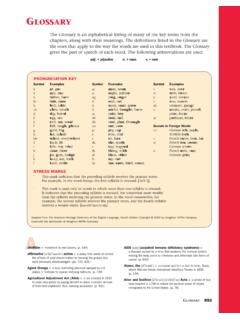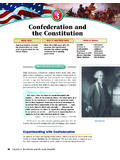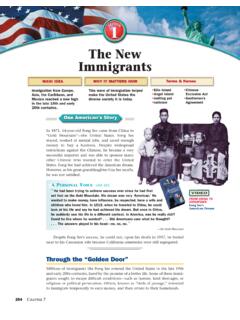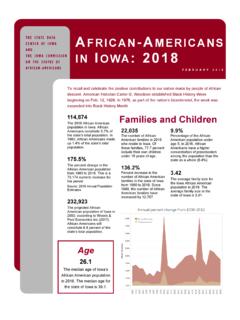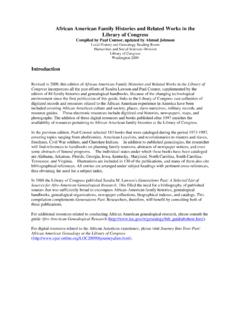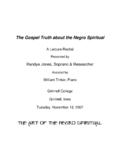Transcription of The Americas, West Africa, and Europe - mrlocke.com
1 4 CHAPTER1 Exploration and the Colonial EraTerms & NamesTerms & NamesMAIN IDEAMAIN IDEAOne american 's StoryThe Americas, west africa , and Europe nomadic Aztec Anasazi Pueblo Iroquois Benin Kongo Islam Christianity Reformation RenaissanceOn the eve of theirinteraction, Native american , west African, and Europeanpeoples lived in interaction of thesecultures helped create thepresent-day culture of theUnited IT MATTERS NOWWHY IT MATTERS NOWE ssie Parrish, a Native american spiritual leader and healer, kept alivestories from a time when her people, the Kashaya Pomo, flourishedalong the northern California coast.
2 One day in 1958, she invitedRobert Oswalt, an anthropologist at the University of California, totime travel with her to the 1540s. As Parrish spoke, the centuriesrolled back. A PERSONALVOICEESSIE PARRISH In the old days, before the white people came up here, there was aboat sailing on the ocean from the south. Because before that .. [the Kashaya Pomo] had never seen a boat, they said, Our world mustbe coming to an end. Couldn t we do something? This big bird floatingon the ocean is from somewhere, probably from up high.. [T]heypromised Our Father [a feast,] saying that destruction was upon they had done so, they watched [the ship] sail way up north anddisappear.
3 They were saying that nothing had happened to them the big bird person had sailed northward without doing anything because of the promise of a feast.. Consequently they held a feastand a big dance. quoted in Kashaya TextsIn this chapter, you will learn about three complex societies thatmet in North america in the late 1400s: the European, the west African,and the Native american . However, it is with the ancient peoples of theAmericas that american history actually begins. Ancient Cultures in the AmericasNo one knows for sure when the first Americans arrived, but it may have been aslong as 22,000 years ago.
4 At that time, the glaciers of the last Ice Age had frozen Dressed for a ceremony in the1950s, spiritual leader EssieParrish wears a featheredheaddress and holds twobead-covered quantities of the earth s water, lowering sea levels and possibly creat-ing a land bridge between Asia and Alaska across what is now the BeringStrait. Ancient hunters may have trekked across the frozen land, known asBeringia, into North AND GATHERINGA rchaeologists believe that the earliestAmericans lived as big-game hunters. That way of life changed around 12,000to 10,000 years ago when temperatures warmed, glaciers melted, and sea lev-els rose once again.
5 The land bridge disappeared under the Bering Sea, bring-ing to an end land travel between the Asian and North american the climate grew warmer, the large animals no longer thrived. People grad-ually switched to hunting smaller game and fish and gathering nuts and DEVELOPSW hile many ancient groups settled in NorthAmerica, others continued south into what is now Mexico and South 10,000 and 5,000 years ago, an agricultural revolution quietly took placein what is now central Mexico. There, people began to plant crops. Eventually,agricultural techniques spread throughout the introduction of agriculture made it possible for people to settle in oneplace and to store surplus food.
6 From this agricultural base developed largercommunities. However, some Native american cultures never adopted agricultureand remainednomadic,moving from place to place in search of food and tribes mixed nomadic and non-nomadic , AZTEC, AND INCA SOCIETIES FLOURISHThe first empire of theAmericas emerged as early as in what is now southern Mexico, wherethe Olmec people created a thriving civilization. In the wake of the Olmec s mys-terious collapse, around , the Maya built a dynamic culture in Guatemalaand the Yucat n Peninsula 250 and 900. Later, theAztecsettled theValley of Mexico in the 1200s and developed a sophisticated South america , the most prominent empire builders were the 1400, the Inca created a glittering empire that stretched nearly 2,500miles along the mountainous western coast of South SOCIETIES ARISE IN NORTH AMERICAIn time, several NorthAmerican groups, including the Hohokam and theAnasazi( QnE-s PzC), intro-duced crops into the arid deserts of the Southwest.
7 Later, between 1400, each group had established its own roamingover 10,000years ago in whatis now southernArizona may haveused this spearpoint to killlarge s renderingof Tenochtitl n,the Aztec capitalin the middle ofLake Texcoco. A MAIN IDEAMAIN IDEAAA nalyzingEffectsWhat werethe effects ofagriculture onthe hunting andgathering peopleof the americas ?To the east and west of the Mississippi River, another series of complex soci-eties developed the Adena, the Hopewell, and the Mississippian. These societiesexcelled at trade and at building massive earthen mounds as tombs and as plat-forms for temples and other buildings.
8 These early peoples were the ancestors of the many Native american groupsthat inhabited North america on the eve of its encounter with the European american Societies of the 1400s The varied regions of the North american continent provided for many differentways of life. The native groups that populated the continent s coasts, deserts, andforests 500 years ago were as diverse as their surroundings. DIVERSE PEOPLESThe inhabitants of California adapted to the region s variedenvironments. The Kashaya Pomo lived in marshlands along the central coast,hunting waterfowl with slingshots and nets. To the north of them, the Yurok andHupa searched the forests for acorns and trapped fish in mountain waterways and forests of the Northwest Coast sustained large communi-ties year-round.
9 On a coastline that stretched from what is now southern Alaskato northern California, groups such as the Kwakiutl, Nootka, and Haida collectedshellfish from the beaches and hunted the ocean for whales, sea otters, and the dry Southwest, the Puebloand Pima tribes, descendants of theAnasazi and Hohokam, lived in multistory houses made of stone or adobe, a sun-dried brick of clay and straw, and grew maize (corn), beans, melons, and squash. Beneath the forest canopy of the Northeast, members of the Iroquois(GrPE-kwoiQ)nation hunted fish and game, such as wild turkeys, deer, and bear. In theNortheast, where winters could be long and harsh, Northeast peoples relied heav-ily on wild animals for clothing and food.
10 In the warmer Southeast, groups livedmainly off the land, growing such crops as maize, squash, and and the Colonial EraBA Northwest powwow, ormultitribalgathering,in Cashmere,Washington state, likethese preserve a500-year culturaltradition. MAIN IDEAMAIN IDEABS ummarizingIn what waysdid early NativeAmerican societiesleave their markupon thelandscape?KWAKIUTLNOOTKACHINOOKKATOCH UMASHSHOSHONEPAIUTENEZ PERCEBLACKFOOTCROWCHEYENNENAVAJOHOPIUTEZ UNIJUMANOHUICHOLAZTECMAYAKIOWA-APACHEPUE BLOMESCALEROAPACHECOMANCHEKIOWAARAPAHOPA WNEEKANSAIOWAOSAGESEMINOLEHITCHITITAINOT USCARORASHAWNEEMIAMIILLINOISPOWHATANSUSQ UEHANNOCKDELAWARENARRAGANSETTPEQUOTWAMPA NOAGHURONALGONQUINOTTAWACREE(CHIPPEWA)PO TAWATOMISAUKOJIBWAMANDANARIKARADAKOTA(Si oux)

